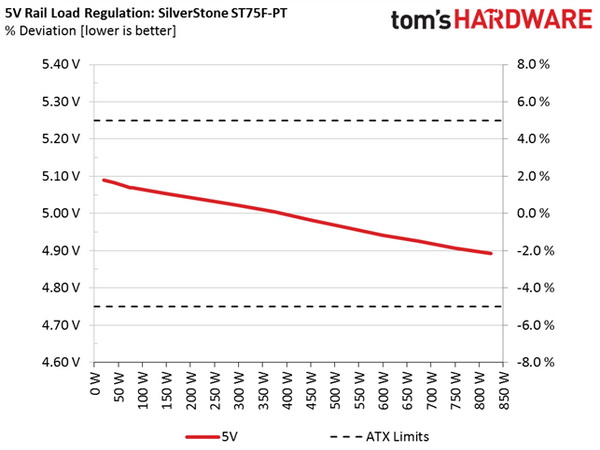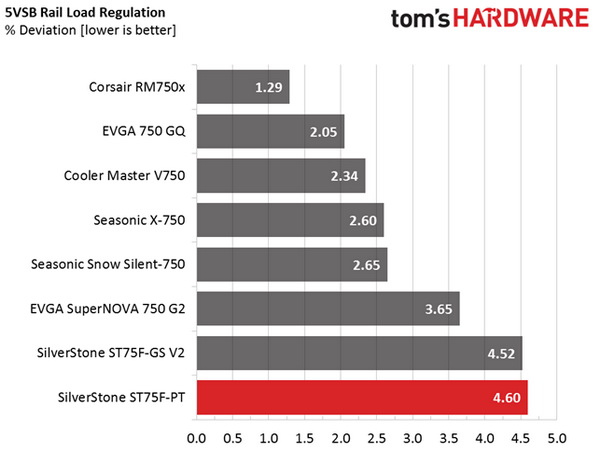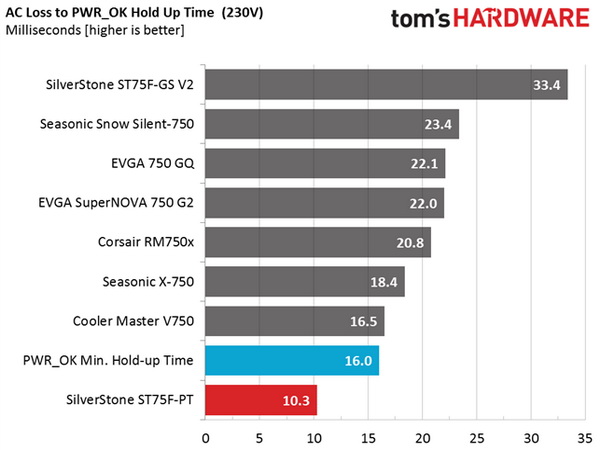SilverStone Strider Platinum 750W Power Supply Review
SilverStone recently expanded its Strider line with three new Platinum-rated units with capacities ranging from 550W to 750W. The family's flagship is being tested today, which includes fully modular cabling and compact dimensions.
Why you can trust Tom's Hardware
Load Regulation, Hold-Up Time And Inrush Current
To learn more about our PSU tests and methodology, please check out How We Test Power Supply Units.
Primary Rails And 5VSB Load Regulation
Load Regulation testing is detailed here.








Hold-Up Time
Our hold-up time tests are described in detail here.






The recorded hold-up time is much lower than the ATX spec's 17ms minimum requirement. Given the bulk cap's low capacity, this comes as no surprise to us. At least the power-good signal drops before the rails go out of spec, and not after like we saw from Zalman's ZM750-EBT, based on the same platform.
Inrush Current
For details on our inrush current testing, please click here.


The lack of an NTC thermistor for protection against large inrush currents results in over 100A of inrush current with 115V input and a greater than 70A reading with 230V. Sirfa must bring this down as soon as possible. We can't help but wonder why the company chose not to include a simple NTC thermistor at next to no cost.
Load Regulation And Efficiency Measurements
The first set of tests explores voltage rail stability and efficiency. The applied load equals (approximately) 10 to 110 percent of the supply's maximum in increments of 10 percentage points.
Get Tom's Hardware's best news and in-depth reviews, straight to your inbox.
We conducted two additional tests. During the first, we stressed the two minor rails (5V and 3.3V) with a high load, while the load at +12V was only 0.10A. This test reveals whether a PSU is Haswell-ready or not. In the second test, we determined the maximum load the +12V rail could handle with minimal load on the minor rails.
| Test # | 12V | 5V | 3.3V | 5VSB | DC/AC (Watts) | Efficiency | Fan Speed (RPM) | Noise (dB[A]) | Temps (In/Out) | PF/AC Volts |
|---|---|---|---|---|---|---|---|---|---|---|
| 1 | 4.371A | 1.972A | 1.961A | 0.991A | 74.78 | 87.41% | 0 | 0 | 49.79 °C | 0.971 |
| 12.169V | 5.069V | 3.361V | 5.044V | 85.55 | 36.51 °C | 115.1V | ||||
| 2 | 9.782A | 2.958A | 2.955A | 1.191A | 149.70 | 90.25% | 1320 | 34.9 | 38.51 °C | 0.988 |
| 12.152V | 5.053V | 3.348V | 5.028V | 165.87 | 39.91 °C | 115.1V | ||||
| 3 | 15.561A | 3.475A | 3.474A | 1.396A | 224.87 | 91.53% | 1300 | 34.7 | 38.84 °C | 0.994 |
| 12.132V | 5.038V | 3.335V | 5.008V | 245.67 | 40.92 °C | 115.1V | ||||
| 4 | 21.357A | 3.983A | 3.970A | 1.601A | 299.75 | 91.50% | 1420 | 36.6 | 40.26 °C | 0.996 |
| 12.107V | 5.022V | 3.323V | 4.988V | 327.60 | 43.17 °C | 115.1V | ||||
| 5 | 26.833A | 4.988A | 4.983A | 1.811A | 374.67 | 91.19% | 1500 | 37.8 | 41.29 °C | 0.996 |
| 12.083V | 5.004V | 3.309V | 4.968V | 410.85 | 45.39 °C | 115.0V | ||||
| 6 | 32.337A | 6.021A | 6.008A | 2.021A | 449.68 | 90.74% | 1530 | 37.9 | 42.09 °C | 0.996 |
| 12.057V | 4.983V | 3.295V | 4.947V | 495.58 | 46.72 °C | 115.0V | ||||
| 7 | 37.870A | 7.049A | 7.038A | 2.230A | 524.60 | 90.12% | 1600 | 40.5 | 43.24 °C | 0.996 |
| 12.029V | 4.962V | 3.282V | 4.927V | 582.14 | 48.71 °C | 115.0V | ||||
| 8 | 43.428A | 8.097A | 8.080A | 2.446A | 599.58 | 89.45% | 1630 | 39.4 | 44.90 °C | 0.997 |
| 12.001V | 4.941V | 3.267V | 4.904V | 670.33 | 51.06 °C | 115.0V | ||||
| 9 | 49.451A | 8.632A | 8.635A | 2.450A | 674.61 | 88.73% | 1630 | 39.4 | 46.23 °C | 0.997 |
| 11.972V | 4.925V | 3.253V | 4.890V | 760.27 | 53.73 °C | 115.0V | ||||
| 10 | 55.254A | 9.171A | 9.170A | 3.091A | 749.47 | 87.85% | 1630 | 39.4 | 47.17 °C | 0.997 |
| 11.941V | 4.906V | 3.238V | 4.850V | 853.09 | 56.07 °C | 115.0V | ||||
| 11 | 61.661A | 9.197A | 9.211A | 3.099A | 824.31 | 87.00% | 1630 | 39.4 | 47.89 °C | 0.998 |
| 11.914V | 4.892V | 3.224V | 4.837V | 947.45 | 58.47 °C | 115.0V | ||||
| CL1 | 0.100A | 14.022A | 14.005A | 0.004A | 117.66 | 82.61% | 1630 | 39.4 | 46.32 °C | 0.985 |
| 12.144V | 4.974V | 3.333V | 5.074V | 142.43 | 52.03 °C | 115.1V | ||||
| CL2 | 62.459A | 1.002A | 1.003A | 1.002A | 759.46 | 88.66% | 1630 | 39.4 | 47.45 °C | 0.997 |
| 11.948V | 4.969V | 3.261V | 4.940V | 856.58 | 56.46 °C | 115.0V |
Load regulation is merely average on all rails. The ST75F-PT clearly cannot match its competition in this area. Under 20 percent load, the unit manages to satisfy the 80 Plus Platinum requirement. That's not the case at 50 percent of its max-rated capacity or full load, however. While we expected better efficiency under demanding loads, it seems that high operating temperatures have a significant impact on this PSU's performance.
The fan doesn't spin during the 10 percent load test, and up to the 30 percent test its output noise is low. It only exceeds 40 dB(A) during the 70 percent load test, likely due to a vibration since the fan's noise level drops below 40 dB(A) at full speed. Acoustic output is low overall thanks to a slow-spinning fan. Of course, the fan profile does get aggressive at high temperatures, which is why SilverStone rates its PSU for full-load operation at up to only 40 °C. For the record, the ST75F-PT easily delivered more than its full power at up to 48 °C ambient in our tests.
Current page: Load Regulation, Hold-Up Time And Inrush Current
Prev Page A Look Inside And Component Analysis Next Page Efficiency, Temperature And Noise
Aris Mpitziopoulos is a contributing editor at Tom's Hardware, covering PSUs.
-
babernet_1 Interesting, but I can't wait for a review on the 800W Titanium Silverstone!Reply
Again, you gave no price for your cost analysis. -
Aris_Mp the price is listed below every page. You have to disable add blocker in order to see it.Reply
For the record it is 145 bucks.
Now that I finished the Platinum review I will deal with the Titanium also. I am sorry for the delay but besides a very heavy schedule I need lots of time to fully evaluate each PSU. -
babernet_1 Ah, thank you. I disabled adblock for Toms and see it now. I am really seriously considering the titanium 800W supply. Hope it is good!Reply
-
Jack_565 I'm also considering buying the 800W Titanium version, it'd be awesome if you could do a review on one.Reply -
Aris_Mp will ask from SilverStone to provide me one, however my schedule is really heavy lately and the sample pile is growing huger day by day :(Reply


